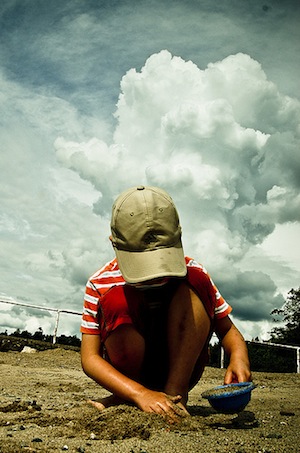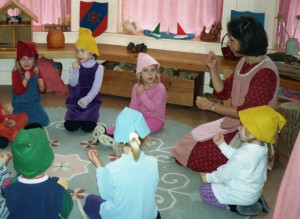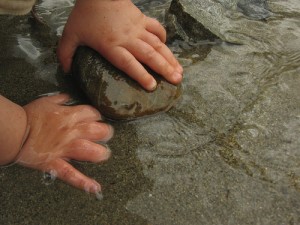On Saturday, I stopped by Free-Range Kids, one of my favorite blogs written by Lenore Skenazy, author of the book by the same name. I was delighted to find there a guest post by Mary O’Connell, a colleague and fellow board member of LifeWays North America. Mary offered an essay about the problem she has with sand tables being considered essential pieces of equipment in early childhood classrooms.
You can read Mary’s essay on Free-Range Kids here.
I was surprised at how many comments were left in relation to this post over the weekend, and astonished to discover how high emotions seemed to be running in defense of sand tables, and how much vitriol some people expressed toward outdoor sandboxes. Who knew? Readers defended the value of sand tables for giving children valuable sensory input (no argument there), but many of them also bashed sandboxes and playing in dirt as being impractical, messy and unsanitary. Having read most of the 90 follow-up comments, I thought many readers were missing Mary’s point, and offered the following comment of my own:
I am a Waldorf early childhood teacher. My take on the essay was not that Mary was condemning the sand table as detrimental for children, but rather that she was trying to raise our consciousness by asking if we are, in effect, replacing children’s outside play time in nature, by attempting to bring those experiences indoors.
Sand tables seem to have become de rigueur pieces of equipment in early childhood classrooms in recent decades. I’ve used a sand table at times, sometimes filled with sand, sometimes with beans, and the children enjoy it. There is nothing inherently wrong with a sand table (even though, Mary’s right that they DO make a mess!).
But I think that Mary’s point is that they shouldn’t become a substitute for the real thing. Children who are lucky enough to have plenty of time for outdoor play in nature will get all the sensory experiences they need in order to develop healthy brains and bodies — by digging in dirt, playing in sandboxes, wading in water, or climbing trees.
Some of us may teach in urban areas with no outdoor play space (but I wonder how many of us don’t even have a concrete playground with room for a covered sandbox). Some of us may live in apartment high-rises with no yard or outdoor space. If there is not even a park in your neighborhood where children can play outdoors, then a sand table could be considered a necessity. One might also want to have a sand table indoors during the cold winter months when the sandbox is frozen. But, in my opinion, sand table play is no substitute for being outside, digging, and making tunnels and mud pies in real dirt
And as to the animal feces argument against sandbox play, it is so easy to cover a sandbox with a tarp at the end of playtime. The children in my class would help with this task everyday. There are also covered sandboxes which are readily available. [Which I just so happen to carry at Bella Luna Toys!]
Just my two cents in defense of Mary’s original argument.
Dear Readers, have a look at Mary’s essay, and let me know what you think. On which side of the sand table do you stand?




10 Comments
Sarah,
Thanks for your comments!
I was surprised to see the heated exchange in regard to the post. Many people are obviously very attached to their sand tables! My intent, as you have suggested, was not to obliterate the beloved sand table, but to raise the question, “Why do we feel we need to tame and control nature out of our fear of it?”
I look forward to seeing what your readers think.
Firstly I wanted to say that I have not yet read the article by Mary, my comment is based on the above text.
I wanted to install a sand table in my home during the winter months as well for my son to play, but my husband said there is now way that sand will be in our kitchen (he is the cook in our house) and in hindsight he was right.
Are we not suppose to celebrate the seasons…., the sandbox and beaches are also a seasonal activity and they should remain so, I think. I never played as a child in a sandbox in the winter months, during that time one should look for winter activities and not summer activities in my opinion. This is similar to those wooden acorns that some people purchase instead of just collecting them from nature and enjoying them in the fall/ winter time. Sometimes it is easy to get caught up with convenience instead of following the seasonal rhythms in nature.
thanks for sharing. i commented over there.
i will share here that we adopted the motto *we weather the weather whatever the weather, whether we like it or not.* 😉
I saw your comment over at Free-Range Kids, Rae, and I loved that quote! So glad you re-posted it here. Wish I’d known it while I was still teaching, when we truly did weather the weather. The only thing that would keep us indoors would be sub-zero weather with a danger of frostbite. I’ve heard that some our local preschools and kindergartens don’t go outside if it’s below 32F. Here in Maine, that would keep children inside for at least three months out of the year! Soon after moving to Maine, I really learned how to dress for the weather — wool long-johns and undershirt, lots of layers, a long down coat, wool hat, warm mittens and shearling lined boots — which allowed me to enjoy many joyful hours outdoors in mid-winter with the children. The children rarely complained about the cold, and when they did, it was usually only those who were inadequately dressed. Once we put an extra layer or hat or warm mittens on them, they would return happily to outdoor winter play.
If we are giving children sand tables at school to provide them with sensory experiences, then I ask: What better way to nourish their senses is there than to let them dig in the dirt, make snow angels, or splash in cool water on a hot day? To experience all the elements with their whole bodies? How could we ever hope to replicate those experiences indoors?
I’m glad you spoke up over there, Sarah. You-and Mary- are exactly right. While the sensory table is a useful tool, it shouldn’t be thought of as the only place for sensory play, and shouldn’t replace the abundant feast for the senses found outdoors. I think it’s true – there is a trend to sanitize our children’s experiences, and it is unfortunately most often to their detriment!
Hi Sara, I love the photos of your watercolor and block crayon experience I wish I could have joined in.
We order an entire truck to deliver a load of sand for our children. They spend hours of endless creative play in their mountain of sand, every day!
Since we’ve had so much tropical rain I just can’t keep them out the mud either.
I haven’t visited Bella Luna for a while so I will visit to see your changes.
Before we moved to our present house four years ago when my son Harper started high school, we had a big farm with lots of land. Early on, an excavator came to do some landscaping work and, while they were at it, we had them dig out a big hole out back. We filled it with a truck-load of sand and used the boulders and big rocks the excavator had dug out to make a ring around the sand pit.
Many happy hours were spent in the sand box when the boys were little, digging tunnels and building mountains. As they grew, they enjoyed jumping off the roof of the neighboring shed into the sand pit, and even later we used it for bonfires. I have happy memories of family gatherings, sitting on the big rocks at night, watching the flickering flames, singing and making music around it.
Those experiences could never be duplicated indoors.
Hello Sarah,
Just a note to say that the link above isn’t working.
http://www.freerangekids.com/why-is-this-thing-in-every-preschool/
seems to be the new link
(PS. I loved your idea of creating a sand-pit in your farm – I’m inspired to something similar in our garden)
Thanks for alerting me, Divya! I have fixed the link. xo Sarah
We live in a small house, with a tiny backyard where we manage to grow flowers, herbs, alpine strawberries, blueberries and 2 or 3 different veggies a year. There is a playstand, with wood chips underneath. It’s important for everyone’s peace to make an effort to tidy away inside and outside, because of the small space. When my child had her 2 year birthday party one mother insisted we needed a sand box or at least a sand table. When I replied that there was no space and that we also were not interested in it, she was very defensive of the sand play. I’m glad Sarah pointed out the purpose of the play with dirt, as I was starting to doubt myself. Now I’m confident we don’t need yet another gimmick to buy. All is there: she has been gardening since age 8months. When she was walking confidently with 10months, I started taking her on hikes in the forest or marsh. On the beach we dig deep holes. We send ‘leaf boats’ down the river. We make bread dough and roast it on sticks over a tiny iron fire pit in the garden. In short my child participates and imitates all the home and family making. Sand stays outside (mostly), it’s not an inside toy. We are however often alone with our outdoor adventures, because many moms around me prefer to leave the kids in artificially created play environments and confuse the Waldorf idea of rhythm with a down to the minute strict feeding, sleeping, playing schedule. I slowly find a few more like minded friends who want to come along. It also takes a little drive out of our urban environment to get to nature but it’s worth it!